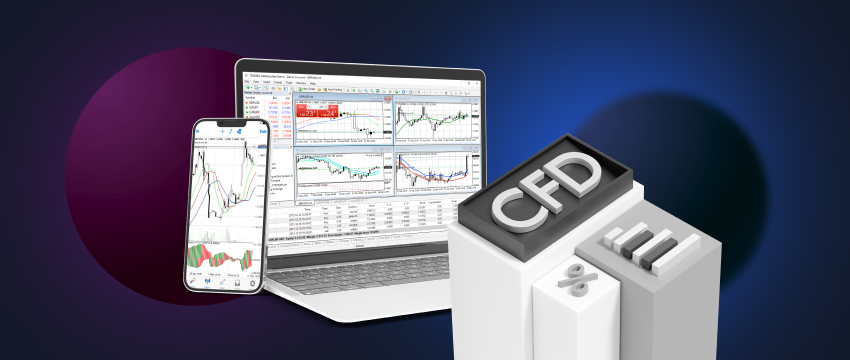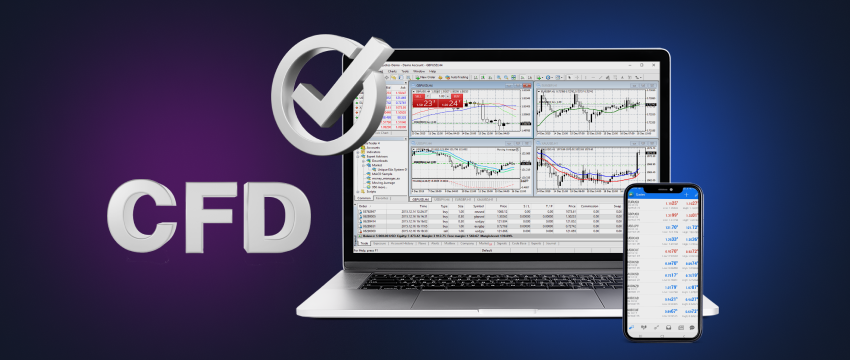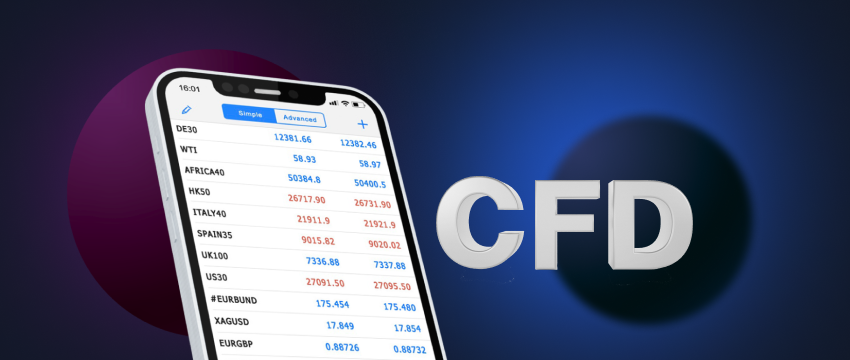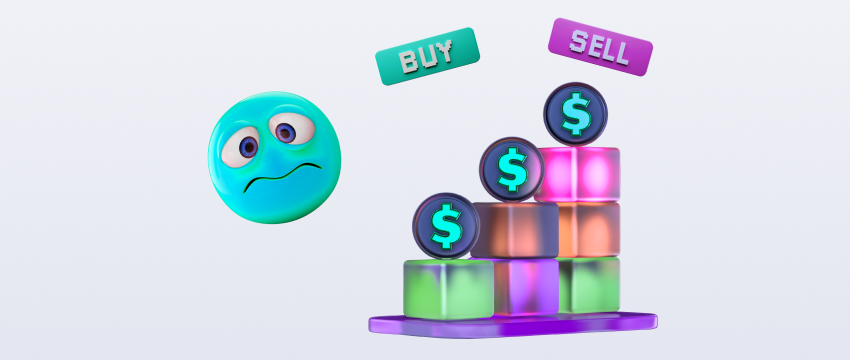Contracts for Difference (or CFDs) are a type of financial derivative which can be used to speculate on the price of an asset. CFDs are a complex instrument, so it is important to learn how they work before you get started. In this article, we’ll discuss six key steps to start trading CFDs.
1. Understand the basics of CFD trading
Understanding CFDs and how they work is crucial before you start CFD trading.
CFDs (Contracts for Difference) are derivative financial instruments that allow you to speculate on the price movements of various global markets, including shares, indices, commodities, and forex, without actually owning the underlying asset.
CFDs are leveraged products, so traders can open a position by paying a small portion of the total trade value, known as a margin. Leverage can amplify profits, but it can also increase the risk of significant losses.
2. Open a trading account
To start trading CFDs, you’ll need a trading account. You’ll use this account to manage your risk, monitor profits and losses, open and close positions, and research new opportunities.
Before committing real money, you can practice risk-free on a demo trading account.
When you’re ready to trade with real money, opening a live account is usually quick and straightforward. Once you fund your account, you’ll be ready to start trading and exploring market opportunities.

3. Choose from CFDs financial market
CFDs offer access to a diverse range of markets for trading. T4Trade provide CFDs on thousands of markets such as:
CFDs 주식
Trade CFDs on some of the most popular company shares, such as Apple, Amazon, Tesla, 그리고 Facebook.
지수
Trade CFDs on global stock indices, such as the Aussie 200 or the German.
외환 CFDs
Participate in one of the most liquid markets in the world with major currency pairs like EUR/USD, GBP/USD, and USD/JPY.
원자재
Explore natural resources by trading CFDs on crude oil, coffee and sugar.
금속 CFDs
Trade CFDs on gold, silver, palladium, or platinum
선물
Enjoy quick execution and no requotes by trading futures on commodities, currencies, or indices.
4. Decide whether to buy or sell
In CFD markets, there are two prices to consider: the buy price (ask) and the sell price (the bid). The difference between these two prices is called the spread.
Both prices are based on the underlying instrument’s price, with the buy price being slightly higher and the sell price slightly lower than the market price. Before opening your position, you will need to decide whether to buy or sell.
If you believe the price of the instrument will rise, you can trade at the buy price (go long). If you expect the price to fall, you can trade at the sell price (go short).
Your profit or loss depends on the market’s movement. If the market moves in the direction you predicted, you’ll make a profit; if it moves against you, you’ll make a loss.
5. Determine your position size
After selecting your market and deciding whether to go long or short, the next step is determining the size of your position. The number of contracts you choose to buy or sell when trading CFDs is entirely up to you.
Each contract represents a specific portion of the underlying asset. For instance, in stock trading, one CFD equals one share. CFDs are traded in the base currency of the underlying market. For example, when trading US stocks, your profit or loss will be calculated in US dollars.
As contracts for difference use leverage, opening a position requires only a small margin, which represents a fraction of the total trade value. In general, the bigger the trade value, the greater the margin that is needed.
It’s essential to make sure your account has adequate funds to cover the required margin. The amount required to open a position will be automatically determined by the trading platform’s margin calculator.
6. Use stop & take-profit orders
CFD trading is influenced by many different factors, including market volatility and unexpected price fluctuations. These can arise from geopolitical events, economic news, central bank announcements, investor sentiment, interest rates, unemployment rates, and more. Without proper monitoring, these factors can negatively impact trading outcomes.
This is why risk management tools are essential to safeguard your funds. Whether through stop-loss orders, take-profit orders, or position sizing, every trader should have a proper risk management plan in place.
Stop-loss order:
A stop-loss order is designed to limit potential losses. It instructs your provider to close your position at a predetermined level, usually lower than the current market price.
Take-profit order:
When the market hits your profit target, a take-profit order is used to automatically lock in profits by instructing your broker to close your position at a better price.
Managing active positions and closing CFDs
Once your position is live, your profit or loss will fluctuate as the underlying market rises and falls.
Trading platforms and mobile apps allow you to monitor market prices, view real-time profit/loss updates, and modify, add, or remove positions as needed.
If you didn’t apply stop-loss or take-profit orderswhen opening your position, these can still be added or adjusted later to align with changing market conditions.
Closing a CFD position:
Closing a CFD involves trading in the opposite direction of your original position. If you bought 100 CFDs, you would sell 100 CFDs to close the position.
When your net open profit or loss is realised, it will reflect in your account balance right away.

Why trade CFDs with T4Trade?
Choosing the right broker is key to meeting your trading goals, and T4Trade goes above and beyond to help you achieve those goals. Here’s how T4Trade stands out:
T4Trade Education:
T4Trade offers a wide range of educational resources through T4Trade Education. These resources include videos, podcasts, webinars, Live TV, an Economic Calendar and blogs, offering trading tips, insights and market analysis.
Tailored accounts:
T4Trade offers multiple trading accounts to suit traders at different stages of their journey and varying levels of expertise.
You can choose from the Standard, Premium, 특권 택하고 Cent accounts.
Start trading and gain access to over 300 underlying instruments across 6 asset classes, all with highly competitive conditions.
Flexible trading conditions:
Traders can enjoy features like flexible leverage to align with their trading strategy, tight spreads for cost-efficient trading, fast withdrawals and deposits to manage funds efficiently, quick execution, and 24/5 multilingual customer support to address their concerns promptly.
Advanced trading platform:
With T4Trade, you can trade using the industry-leading MetaTrader 4 platform. This innovative platform provides access to some of the most advanced trading tools available in the world.
This includes powerful technical analysis tools, automated trading, technical indicators, charting, symbols, etc.

In summary
Starting CFD trading can be exciting, but it’s important to approach it with a solid understanding and well-planned strategy.
By following the six key steps outlined above, understanding the basics, choosing a market, deciding whether to buy or sell, determining your position size, and using stop-loss and take-profit orders, you’ll be well on your way to becoming a successful trader.
As you gain experience, you’ll be able to make more informed decisions and manage risks effectively. Using risk management tools like stop-loss and take-profit orders will help you to minimise risk and maximise potential gains.
By choosing a reliable broker like T4Trade, you can benefit from their educational resources, flexible account options, competitive trading conditions, and access to advanced trading tools. Start your CFD trading journey with T4Trade today and take advantage of the support and tools available to help you reach your trading goals.
Disclaimer: This material is for general informational and educational purposes only and should not be considered investment advice or an investment recommendation. T4Trade is not responsible for any data provided by third parties referenced or hyperlinked in this communication.




